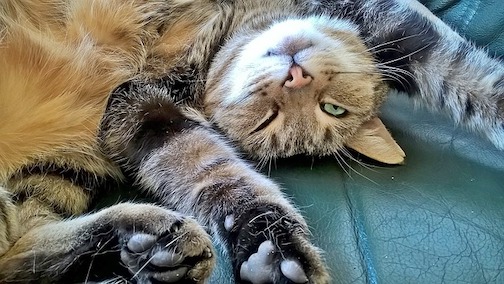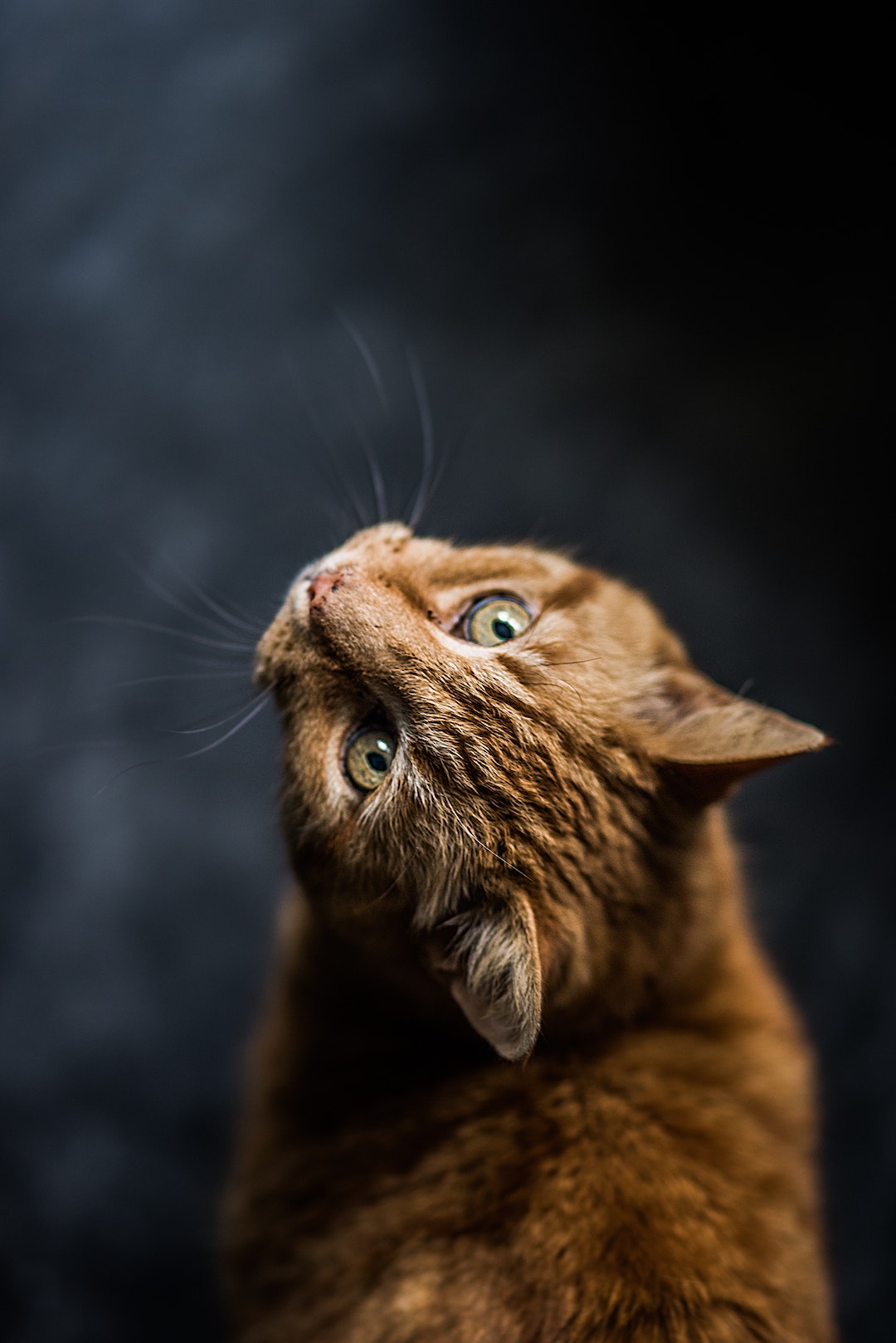How to Reduce Your Cat’s Stress Levels
Posted: 03/01/2023 | BY: Erin Cain | Categories: Behavior , Cat , Pet care
Cat parents know the signs of an unhappy cat quite well: hiding under beds and couches, hissing and growling at perceived threats and fears, odd sleeping habits, overgrooming, inappropriate scratching and urinating or defecating outside the litter box. When your cat is stressed out, your job as a pet parent is to identify the offending stressors and try to create a calmer environment for your kitty. In making an effort to make your cat’s life a happier one, you will also make it a healthier one. Here are some reasons why cats become stressed, along with some quick ways to reduce your cat’s stress levels.

Why do cats get stressed?
Cats may suffer from acute and chronic stress; acute stress is easily recognizable and frequently seen when your cat goes for a car ride to the veterinarian’s office. Chronic stress is more subtle and overlooked, especially in busy households. Often, gradual changes in a cat’s behavior occur as a result of chronic stress. Unfortunately, those changes are so unnoticeable at first, that stress builds up, leading to long-term behavioral and health problems, such as urinary tract infections, weight loss, upset stomach, lethargy, pain and fever.
Change is a primary source of anxiety in all pets, and the following reasons are common causes for stress-related behaviors in felines:
- New persons, caretakers, or pets have been introduced, or people and pets have been removed from the cat’s home and territory.
- Transportation in vehicles or planes.
- Environmental changes, such as a new vacuum, changed litter box locations, changes in diets and feeding locations, etc.
- Home construction or repairs.
- Seeing other animals, particularly cats, outside the home.
- Too much competition for food resources from other cats or pets.
- Boredom.
Whatever the reasons for your cat’s concerns, there are steps you can take to destress your kitty so she can live her best life.
Create a calm, peaceful feeding environment.
Want to reduce your cat’s stress levels without a complete home makeover? Start with your cat’s feeding situation. Cats can become stressed at feeding time if they have to navigate through challenging obstacles and circumstances to get to their food bowl, including other cats or pets, like dogs. Some cats eat in a stressed state because they are defensive against other cats who may push them away. Here’s how to improve your cat’s feeding time:
- Place the food bowl in an appropriate location (i.e., not the bathroom or near the litter box). If you own more than one cat, set up separate, elevated feeding stations so the stressed kitty can eat in peace.
- Find a whisker-friendly bowl that has a comfortable shape and size. Also, keep your cat’s food bowl in a separate place from her water bowl and have individual bowls for each cat in your home, so they don’t feel their access to food is threatened by their feline friends.
- Put the food bowl in a quiet space where sudden noises are rare and where other household pets, like dogs, can’t access the food or frighten the cat.
- Place the food bowl and water bowl some distance apart, as many cats don’t care for having their water by their food.
If you have more than one cat, consider separate feeding rooms where the door can be closed to prevent the other cat’s entrance and access to the stressed cat’s bowl.

Assess and change your litter box setup.
Changes in litter box location and litter type can result in a stressed and anxious kitty. There are some easy fixes to your litter box setup that can improve your cat’s well-being.
First, make sure that your cat’s litter boxes are of appropriate size and shape. If your cat uses a litter box that’s too small or covered or uncovered, she may be unhappy with her elimination station. Find a box that is comfortable for her to use for her size, about 1 and ½ times the length of your cat measuring from the base of the tail to the nose. Be sure to have a box on every floor of your home to which your cat has access. Be careful introducing self-cleaning boxes, as cats who are accustomed to regular litter boxes may become upset by this change.
Then, address any problems with the litter content itself. Most cats are picky when it comes to texture, and they prefer a scoopable, fine and soft litter. When you find a litter your cat likes, stick with it; changing litter types can also trigger feline stress. A clean box is equally important to your cat, so plan to scoop her boxes at least twice a day. Don’t forget that multi-cat households should follow a simple rule of paw: have one litter box per cat in the household, then add one more box.
Try Using Cat Calming Products
If you haven’t tried a product called Feliway, you will be amazed at how it can help your cat feel calm, relaxed and safe. Feliway is a synthetic pheromone that mimics a cat mother’s pheromones she emits after her kittens are born. Though synthetic, Feliway works in the same way, keeping cats of all ages feeling stress-free and relaxed. The product comes in a plug-in diffuser, which steadily diffuses the pheromone out into the room all day and night, much like a plug-in air freshener. Diffusers typically last for one month.
There are other calming products such as cat calming collars and Bach’s Pet Rescue Remedy as well as vitamin B calming chews and liquids.
Get Your Cat a Checkup
Cats can exhibit the same symptoms for an illness that they do for stress. If your cat is acting “off”, it could be that she is feeling unwell or in pain. The usual suspects are dental issues and arthritis, which are very common in older cats. Whenever your cat isn’t acting like herself, it’s always best to take her in to get checked out by the vet.
Spend time playing with your cat.
Domestic cats are often indoor-only pets, and while that provides them security and shelter, it also means they are in the same rooms every day of their lives. That lack of diversity can cause stress in a cat.
You can combat this potential stressor in your cat by spending more time regularly playing and cuddling with her. Consider breaking up the monotony of her day with some stress-reducing playtime. Try toy wands, laser toys, puzzle toys, tunnels, catnip kick sticks and other activities to alleviate your cat’s boredom and resulting stress.
Talk with your vet about medications and supplements.
If your cat is so stressed that the above suggestions fail to resolve her troubles, you may wish to discuss medical and supplemental options with your veterinarian. They may suggest inexpensive over-the-counter methods, such as diffusers, plug-ins, sprays and wipes with pheromones, naturally occurring molecules that calm cats down. Natural supplements like L-theanine and specialized diets are also useful options that may be beneficial for an anxious kitty. Your veterinarian may also recommend and prescribe stress-reducing medications such as gabapentin, fluoxetine or amitriptyline.
Pet insurance can help keep your cat happy and stress-free.
In many cats, stress is not a pre-existing condition; thus, if you have a pet insurance policy for your cat, there’s a good chance that policy will cover most of the costs of her care, vet visits, and medications. Don’t have pet insurance for your cat? Get a free quote today, and make sure whatever your cat needs to be happy and healthy, you can finance it with the help of your pet insurance policy.
References:
- Stella, J., Croney, C., and Buffington, T. (2013). Effects of stressors on the behavior and physiology of domestic cats. Retrieved from https://www.ncbi.nlm.nih.gov/pmc/articles/PMC4157662/
- Johnson-Bennett, P. (2021). Create a Peaceful Mealtime for Your Cat. Retrieved from https://catbehaviorassociates.com/create-a-peaceful-mealtime-for-your-cat/
- Miksen, C. (2021). Should Cats Have Their Own Food Bowl? Retrieved from https://pets.thenest.com/should-cats-own-food-bowl-7118.html
- The Humane Society of the United States. (2021). Preventing litter box problems. Retrieved from https://www.humanesociety.org/resources/preventing-litter-box-problems
- Jessica. (2018). Pheromones – What They Are and What They Aren’t. Retrieved from https://felineengineering.com/blog/pheromones/
Disclaimer
The information contained on this blog is intended for informational and educational purposes only and should not be construed as medical advice. It is not a substitute for professional veterinary care. Always consult with your veterinarian before making any changes to your pet's health care or treatment plan.
The authors of this blog are not veterinarians and do not claim to be experts in pet health. The information provided here is based on our own experiences and research, as well as information from reputable sources. However, we cannot guarantee the accuracy or completeness of this information.
We encourage you to do your own research and consult with your veterinarian before making any decisions about your pet's health.
Previous post
Dog Cataract Surgery CostNext post
Why is My Dog Drinking So Much Water?Compare top pet insurance providers plans.
Enter your dog’s age in years and months to calculate their age equivalent to human years.
Calculate your dog’s ageEnter your cat’s age in years and months to calculate their age equivalent to human years.
Calculate your cat’s age